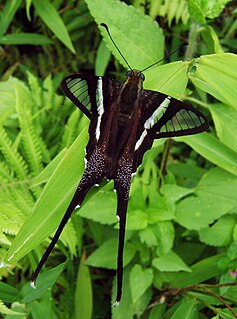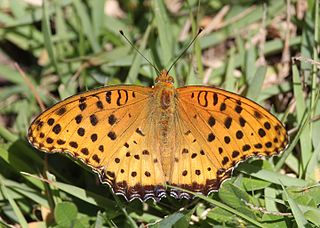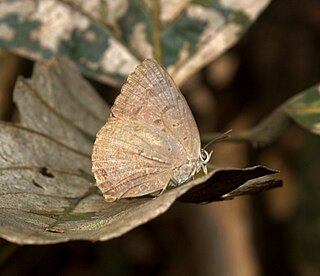
Lamproptera curius, the white dragontail, is a species of swallowtail butterfly native to parts of South Asia and Southeast Asia where it is common. It belongs to the dragontails genus, Lamproptera, of the swallowtail family, Papilionidae.

Appias lalage, the spot puffin, is a small butterfly of the family Pieridae, that is, the yellows and whites, which is found in India, Indochina and Hainan.

The Indian fritillary is a species of butterfly of the nymphalid or brush-footed family. It is usually found from south and southeast Asia to Australia.

Ionolyce helicon, the pointed lineblue, or bronze lineblue, is a small butterfly found in the Indomalayan realm that belongs to the lycaenids or blues family.

Arhopala abseus, the aberrant oakblue or aberrant bushblue, is a species of lycaenid or blue butterfly found in Asia.

Arhopala atrax, the dark broken-band oakblue or Indian oakblue, is a species of lycaenid or blue butterfly found in the Indomalayan realm.

Arhopala bazaloides, the Tamil oakblue, is a species of lycaenid or blue butterfly found in Asia. Also known as Lycaenidae, they are members of the superfamily Papilionoidea, the true butterflies. This family has approximately 4,700 species that are unevenly distributed throughout the world, however the distribution of the Tamil oakblue is limited only to India, Myanmar and Sri Lanka.

Zesius chrysomallus, the redspot, is a species of lycaenid or blue butterfly found in Sri Lanka and India.

Deudorix epijarbas, the cornelian or hairy line blue, is a species of lycaenid or blue butterfly found in south and southeast Asia from India to Fiji, including the Philippines, and also the tropical coast of Queensland in Australia. The species was first described by Frederic Moore in 1857.

Deudorix perse, the large guava blue, is a species of lycaenid or blue butterfly found in the Indomalayan realm. It was described by William Chapman Hewitson in 1863. The larva feeds on Randia dumetorum.

Rapala varuna, the indigo flash, is a species of lycaenid or blue butterfly found in the Indomalayan realm and the Australasian realm.
Lipocosma grimbaldalis is a moth in the family Crambidae described by William Schaus in 1924. It is found in Guatemala.
Microphysetica ambialis is a moth in the family Crambidae. It was described by William Schaus in 1924. It is found in Mexico (Xalapa) and Guatemala.
Proleucinodes lucealis is a moth in the family Crambidae. It was described by Cajetan Felder, Rudolf Felder and Alois Friedrich Rogenhofer in 1875. It is found in French Guiana and Brazil.
Pycnarmon leucinodialis is a moth in the family Crambidae described by William Schaus in 1912. It is found in Costa Rica.
Stenorista fortunata is a moth in the family Crambidae. It was described by Schaus in 1912. It is found in Costa Rica.
Syllepte maculilinealis is a moth in the family Crambidae. It was described by George Hampson in 1918. It is found in Uganda.
Udea poasalis is a moth in the family Crambidae. It was described by Schaus in 1912. It is found in Costa Rica.
Ulopeza sterictodes is a moth in the family Crambidae. It was described by George Hampson in 1912. It is found in Papua New Guinea.
Gonionota dissita is a moth in the family Depressariidae. It was described by Clarke in 1964. It is found in Trinidad.









